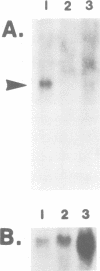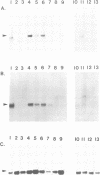Abstract
Adult urodele amphibians such as the newt Notophthalmus viridescens are capable of regenerating their limbs and tail by formation of a blastema, a growth zone of mesenchymal progenitor cells. In an attempt to identify genes implicated in specification of the regenerate, we screened a newt forelimb blastema cDNA library with homeobox probes, and isolated and sequenced clones that identify a 1.8 kb polyadenylated transcript containing a homeobox. The transcript is derived from a single gene called NvHbox 1, the newt homologue of XIHbox 1 (Xenopus), HHO.c8 (human) and Hox-6.1 (mouse). The cDNA for the 1.8 kb transcript has two exons as determined by isolation and partial sequencing of a genomic clone. The expression of the transcript shows several interesting features in relation to limb regeneration: (i) Hybridization of Northern blots of poly(A)+ RNA from limb and tail and their respective blastemas shows that the transcript in limb tissues has exons 1 and 2, whereas a 1.8 kb transcript in tail tissues has only exon 2. (ii) The transcript is expressed in limbs of adult newt but not of adult Xenopus, raising the possibility that this contributes to an explanation of the loss of regenerative ability with maturation in adult anurans. (iii) The transcript is expressed at a higher level in a proximal (mid-humerus) blastema than in a distal one (mid-radius). When distal blastemas were proximalized by treatment with retinoic acid, no change in the level of the transcript was detected by Northern analysis at a single time point after amputation.(ABSTRACT TRUNCATED AT 250 WORDS)
Full text
PDF



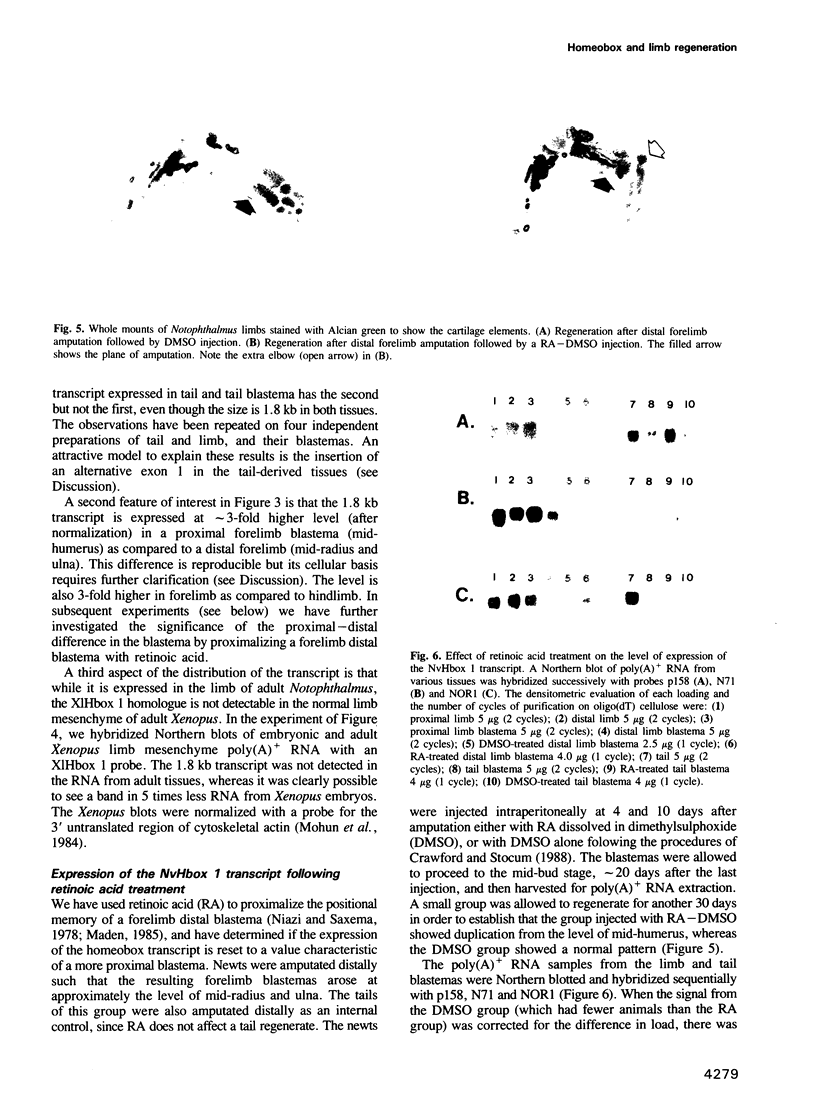

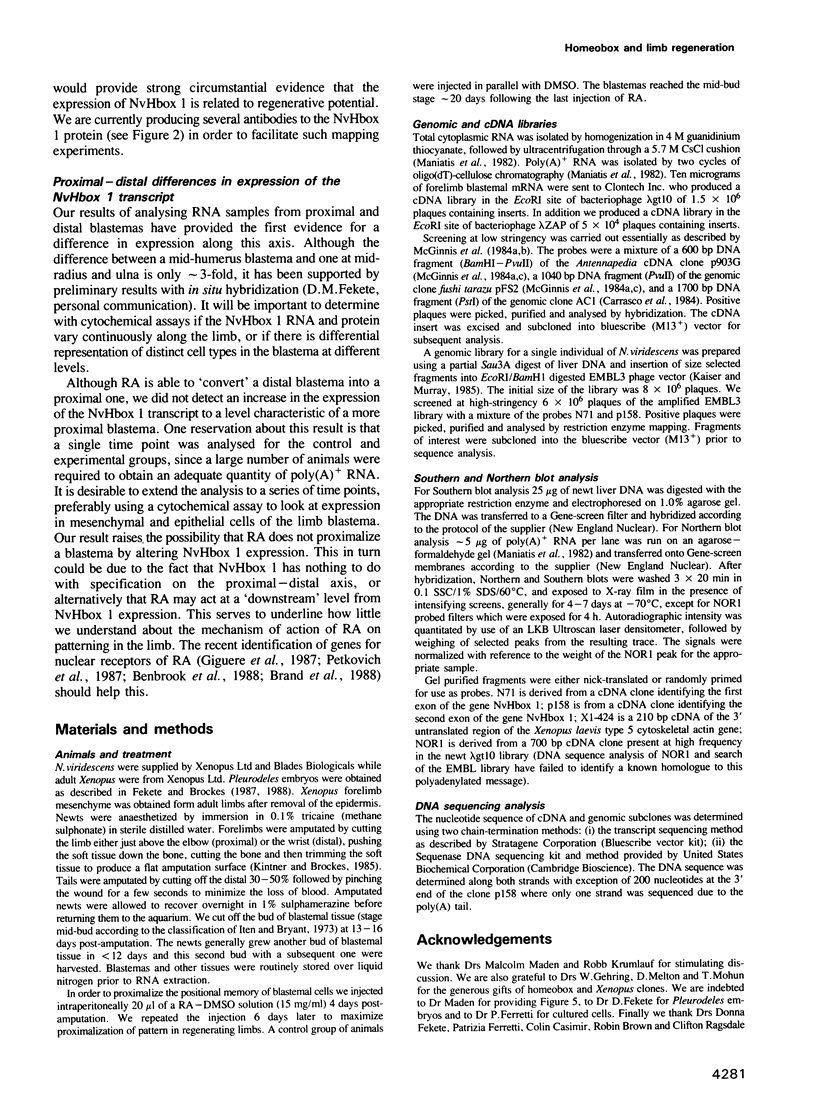
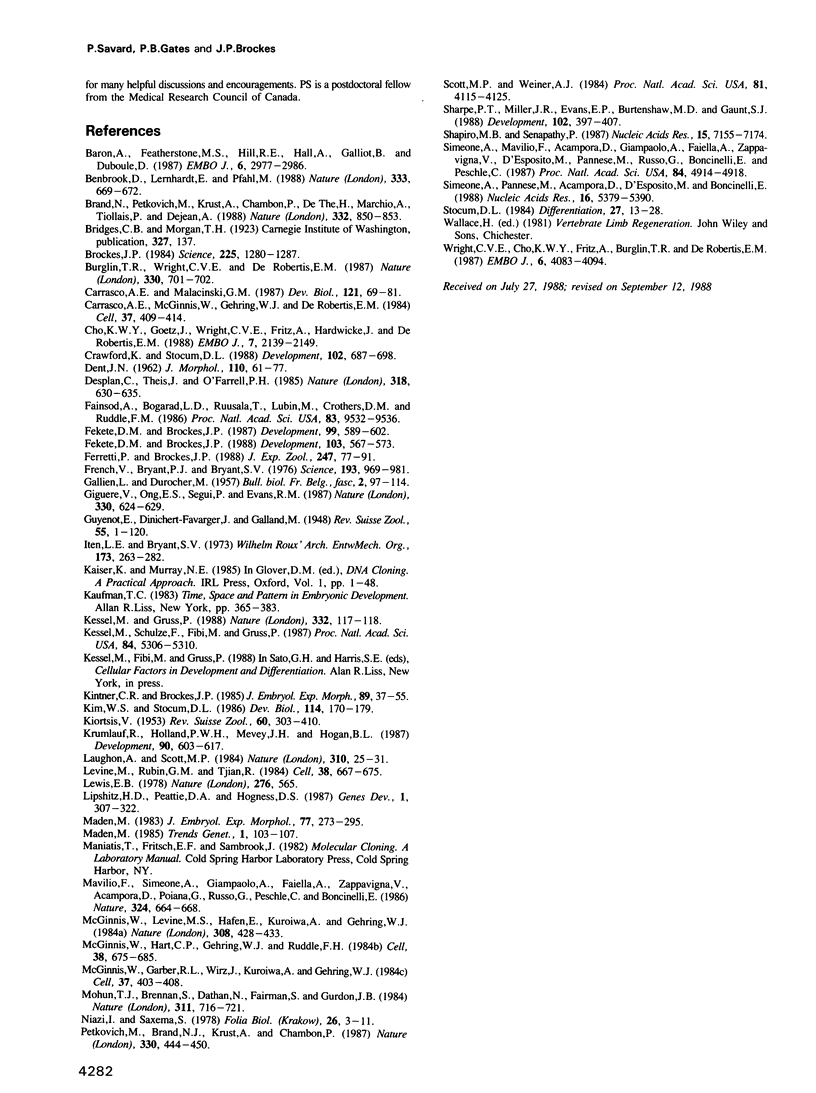
Images in this article
Selected References
These references are in PubMed. This may not be the complete list of references from this article.
- Baron A., Featherstone M. S., Hill R. E., Hall A., Galliot B., Duboule D. Hox-1.6: a mouse homeo-box-containing gene member of the Hox-1 complex. EMBO J. 1987 Oct;6(10):2977–2986. doi: 10.1002/j.1460-2075.1987.tb02603.x. [DOI] [PMC free article] [PubMed] [Google Scholar]
- Benbrook D., Lernhardt E., Pfahl M. A new retinoic acid receptor identified from a hepatocellular carcinoma. Nature. 1988 Jun 16;333(6174):669–672. doi: 10.1038/333669a0. [DOI] [PubMed] [Google Scholar]
- Brand N., Petkovich M., Krust A., Chambon P., de Thé H., Marchio A., Tiollais P., Dejean A. Identification of a second human retinoic acid receptor. Nature. 1988 Apr 28;332(6167):850–853. doi: 10.1038/332850a0. [DOI] [PubMed] [Google Scholar]
- Brockes J. P. Mitogenic growth factors and nerve dependence of limb regeneration. Science. 1984 Sep 21;225(4668):1280–1287. doi: 10.1126/science.6474177. [DOI] [PubMed] [Google Scholar]
- Bürglin T. R., Wright C. V., De Robertis E. M. Translational control in homoeobox mRNAs? Nature. 1987 Dec 24;330(6150):701–702. doi: 10.1038/330701c0. [DOI] [PubMed] [Google Scholar]
- Carrasco A. E., Malacinski G. M. Localization of Xenopus homoeo-box gene transcripts during embryogenesis and in the adult nervous system. Dev Biol. 1987 May;121(1):69–81. doi: 10.1016/0012-1606(87)90139-4. [DOI] [PubMed] [Google Scholar]
- Carrasco A. E., McGinnis W., Gehring W. J., De Robertis E. M. Cloning of an X. laevis gene expressed during early embryogenesis coding for a peptide region homologous to Drosophila homeotic genes. Cell. 1984 Jun;37(2):409–414. doi: 10.1016/0092-8674(84)90371-4. [DOI] [PubMed] [Google Scholar]
- Cho K. W., Goetz J., Wright C. V., Fritz A., Hardwicke J., De Robertis E. M. Differential utilization of the same reading frame in a Xenopus homeobox gene encodes two related proteins sharing the same DNA-binding specificity. EMBO J. 1988 Jul;7(7):2139–2149. doi: 10.1002/j.1460-2075.1988.tb03053.x. [DOI] [PMC free article] [PubMed] [Google Scholar]
- Crawford K., Stocum D. L. Retinoic acid coordinately proximalizes regenerate pattern and blastema differential affinity in axolotl limbs. Development. 1988 Apr;102(4):687–698. doi: 10.1242/dev.102.4.687. [DOI] [PubMed] [Google Scholar]
- DENT J. N. Limb regeneration in larvae and metamorphosing individuals of the South African clawed toad. J Morphol. 1962 Jan;110:61–77. doi: 10.1002/jmor.1051100105. [DOI] [PubMed] [Google Scholar]
- Desplan C., Theis J., O'Farrell P. H. The Drosophila developmental gene, engrailed, encodes a sequence-specific DNA binding activity. Nature. 1985 Dec 19;318(6047):630–635. doi: 10.1038/318630a0. [DOI] [PMC free article] [PubMed] [Google Scholar]
- Fainsod A., Bogarad L. D., Ruusala T., Lubin M., Crothers D. M., Ruddle F. H. The homeo domain of a murine protein binds 5' to its own homeo box. Proc Natl Acad Sci U S A. 1986 Dec;83(24):9532–9536. doi: 10.1073/pnas.83.24.9532. [DOI] [PMC free article] [PubMed] [Google Scholar]
- Fekete D. M., Brockes J. P. A monoclonal antibody detects a difference in the cellular composition of developing and regenerating limbs of newts. Development. 1987 Apr;99(4):589–602. doi: 10.1242/dev.99.4.589. [DOI] [PubMed] [Google Scholar]
- Fekete D. M., Brockes J. P. Evidence that the nerve controls molecular identity of progenitor cells for limb regeneration. Development. 1988 Jul;103(3):567–573. doi: 10.1242/dev.103.3.567. [DOI] [PubMed] [Google Scholar]
- Ferretti P., Brockes J. P. Culture of newt cells from different tissues and their expression of a regeneration-associated antigen. J Exp Zool. 1988 Jul;247(1):77–91. doi: 10.1002/jez.1402470111. [DOI] [PubMed] [Google Scholar]
- French V., Bryant P. J., Bryant S. V. Pattern regulation in epimorphic fields. Science. 1976 Sep 10;193(4257):969–981. doi: 10.1126/science.948762. [DOI] [PubMed] [Google Scholar]
- Giguere V., Ong E. S., Segui P., Evans R. M. Identification of a receptor for the morphogen retinoic acid. Nature. 1987 Dec 17;330(6149):624–629. doi: 10.1038/330624a0. [DOI] [PubMed] [Google Scholar]
- Kessel M., Gruss P. Open reading frames and translational control. Nature. 1988 Mar 10;332(6160):117–118. doi: 10.1038/332117c0. [DOI] [PubMed] [Google Scholar]
- Kessel M., Schulze F., Fibi M., Gruss P. Primary structure and nuclear localization of a murine homeodomain protein. Proc Natl Acad Sci U S A. 1987 Aug;84(15):5306–5310. doi: 10.1073/pnas.84.15.5306. [DOI] [PMC free article] [PubMed] [Google Scholar]
- Kim W. S., Stocum D. L. Retinoic acid modifies positional memory in the anteroposterior axis of regenerating axolotl limbs. Dev Biol. 1986 Mar;114(1):170–179. doi: 10.1016/0012-1606(86)90393-3. [DOI] [PubMed] [Google Scholar]
- Kintner C. R., Brockes J. P. Monoclonal antibodies to the cells of a regenerating limb. J Embryol Exp Morphol. 1985 Oct;89:37–55. [PubMed] [Google Scholar]
- Krumlauf R., Holland P. W., McVey J. H., Hogan B. L. Developmental and spatial patterns of expression of the mouse homeobox gene, Hox 2.1. Development. 1987 Apr;99(4):603–617. doi: 10.1242/dev.99.4.603. [DOI] [PubMed] [Google Scholar]
- Laughon A., Scott M. P. Sequence of a Drosophila segmentation gene: protein structure homology with DNA-binding proteins. Nature. 1984 Jul 5;310(5972):25–31. doi: 10.1038/310025a0. [DOI] [PubMed] [Google Scholar]
- Levine M., Rubin G. M., Tjian R. Human DNA sequences homologous to a protein coding region conserved between homeotic genes of Drosophila. Cell. 1984 Oct;38(3):667–673. doi: 10.1016/0092-8674(84)90261-7. [DOI] [PubMed] [Google Scholar]
- Lewis E. B. A gene complex controlling segmentation in Drosophila. Nature. 1978 Dec 7;276(5688):565–570. doi: 10.1038/276565a0. [DOI] [PubMed] [Google Scholar]
- Lipshitz H. D., Peattie D. A., Hogness D. S. Novel transcripts from the Ultrabithorax domain of the bithorax complex. Genes Dev. 1987 May;1(3):307–322. doi: 10.1101/gad.1.3.307. [DOI] [PubMed] [Google Scholar]
- Maden M. The effect of vitamin A on the regenerating axolotl limb. J Embryol Exp Morphol. 1983 Oct;77:273–295. [PubMed] [Google Scholar]
- Mavilio F., Simeone A., Giampaolo A., Faiella A., Zappavigna V., Acampora D., Poiana G., Russo G., Peschle C., Boncinelli E. Differential and stage-related expression in embryonic tissues of a new human homoeobox gene. Nature. 1986 Dec 18;324(6098):664–668. doi: 10.1038/324664a0. [DOI] [PubMed] [Google Scholar]
- McGinnis W., Garber R. L., Wirz J., Kuroiwa A., Gehring W. J. A homologous protein-coding sequence in Drosophila homeotic genes and its conservation in other metazoans. Cell. 1984 Jun;37(2):403–408. doi: 10.1016/0092-8674(84)90370-2. [DOI] [PubMed] [Google Scholar]
- McGinnis W., Hart C. P., Gehring W. J., Ruddle F. H. Molecular cloning and chromosome mapping of a mouse DNA sequence homologous to homeotic genes of Drosophila. Cell. 1984 Oct;38(3):675–680. doi: 10.1016/0092-8674(84)90262-9. [DOI] [PubMed] [Google Scholar]
- McGinnis W., Levine M. S., Hafen E., Kuroiwa A., Gehring W. J. A conserved DNA sequence in homoeotic genes of the Drosophila Antennapedia and bithorax complexes. 1984 Mar 29-Apr 4Nature. 308(5958):428–433. doi: 10.1038/308428a0. [DOI] [PubMed] [Google Scholar]
- Mohun T. J., Brennan S., Dathan N., Fairman S., Gurdon J. B. Cell type-specific activation of actin genes in the early amphibian embryo. Nature. 1984 Oct 25;311(5988):716–721. doi: 10.1038/311716a0. [DOI] [PubMed] [Google Scholar]
- Niazi I. A., Saxena S. Abnormal hind limb regeneration in tadpoles of the toad, Bufo andersoni, exposed to excess vitamin A. Folia Biol (Krakow) 1978;26(1):3–8. [PubMed] [Google Scholar]
- Petkovich M., Brand N. J., Krust A., Chambon P. A human retinoic acid receptor which belongs to the family of nuclear receptors. Nature. 1987 Dec 3;330(6147):444–450. doi: 10.1038/330444a0. [DOI] [PubMed] [Google Scholar]
- Scott M. P., Weiner A. J. Structural relationships among genes that control development: sequence homology between the Antennapedia, Ultrabithorax, and fushi tarazu loci of Drosophila. Proc Natl Acad Sci U S A. 1984 Jul;81(13):4115–4119. doi: 10.1073/pnas.81.13.4115. [DOI] [PMC free article] [PubMed] [Google Scholar]
- Shapiro M. B., Senapathy P. RNA splice junctions of different classes of eukaryotes: sequence statistics and functional implications in gene expression. Nucleic Acids Res. 1987 Sep 11;15(17):7155–7174. doi: 10.1093/nar/15.17.7155. [DOI] [PMC free article] [PubMed] [Google Scholar]
- Sharpe P. T., Miller J. R., Evans E. P., Burtenshaw M. D., Gaunt S. J. Isolation and expression of a new mouse homeobox gene. Development. 1988 Feb;102(2):397–407. doi: 10.1242/dev.102.2.397. [DOI] [PubMed] [Google Scholar]
- Simeone A., Mavilio F., Acampora D., Giampaolo A., Faiella A., Zappavigna V., D'Esposito M., Pannese M., Russo G., Boncinelli E. Two human homeobox genes, c1 and c8: structure analysis and expression in embryonic development. Proc Natl Acad Sci U S A. 1987 Jul;84(14):4914–4918. doi: 10.1073/pnas.84.14.4914. [DOI] [PMC free article] [PubMed] [Google Scholar]
- Simeone A., Pannese M., Acampora D., D'Esposito M., Boncinelli E. At least three human homeoboxes on chromosome 12 belong to the same transcription unit. Nucleic Acids Res. 1988 Jun 24;16(12):5379–5390. doi: 10.1093/nar/16.12.5379. [DOI] [PMC free article] [PubMed] [Google Scholar]
- Stocum D. L. The urodele limb regeneration blastema. Determination and organization of the morphogenetic field. Differentiation. 1984;27(1):13–28. doi: 10.1111/j.1432-0436.1984.tb01403.x. [DOI] [PubMed] [Google Scholar]
- Wright C. V., Cho K. W., Fritz A., Bürglin T. R., De Robertis E. M. A Xenopus laevis gene encodes both homeobox-containing and homeobox-less transcripts. EMBO J. 1987 Dec 20;6(13):4083–4094. doi: 10.1002/j.1460-2075.1987.tb02754.x. [DOI] [PMC free article] [PubMed] [Google Scholar]




